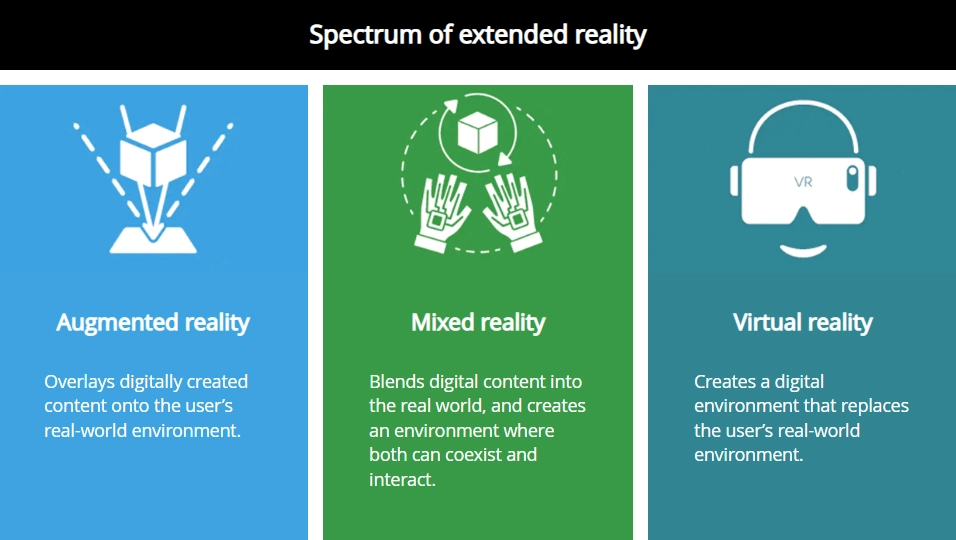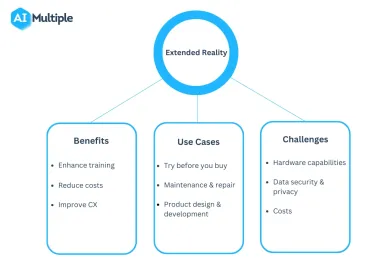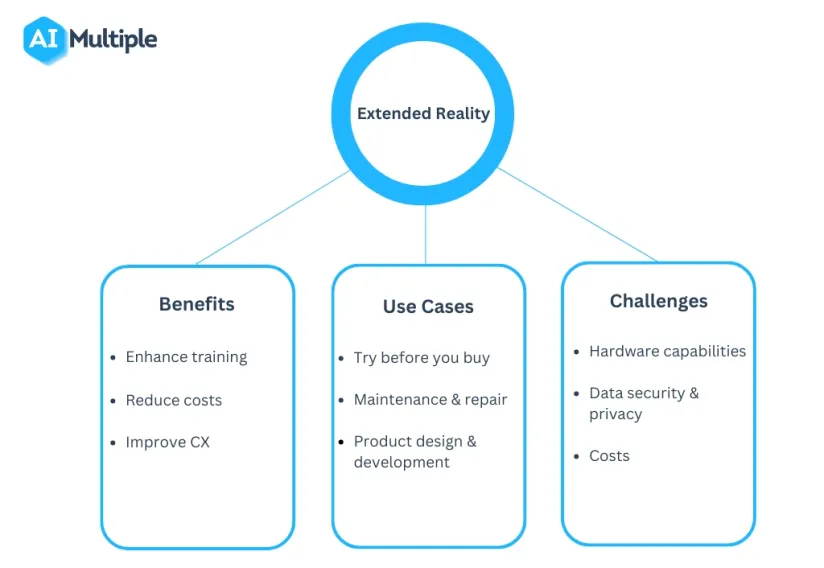XR includes immersive technologies that are set to create opportunities for firms thanks to 3 trends. Though these predictions are unlikely to be exactly realized, they point to increased investment and interest in XR:
1- Metaverse is coming: Analysts predict that 25% of people will spend at least one hour a day in a metaverse for work, shopping, education, social media, and entertainment within this decade.1 This will increase the adoption of XR as one of the enabler technologies of the metaverse.
2- Rising deskless workforce: Deskless workers (in retail, healthcare, manufacturing, construction, etc.) constitute 80% of the global workforce, and 60% are reporting a lack of satisfaction or a need for improvement in the tech they use.2 AR can increase diskless workers’ efficiency by helping them interact with the digital world seamlessly.
3- Consumer adoption of AR: Snapchat’s global AR report predicts that 75% of the global population will be frequent AR users by 2025. We expect adoption to be significantly slower but AR can still be an important enabler for XR.3
Becoming an early adopter will ease navigating this new digital transformation which will affect almost all businesses and consumers.
What is extended reality?
Figure 1: Spectrum of extended reality

Source: Deloitte
Extended reality (XR) is an umbrella term for all immersive technologies (see Figure 1), which consist of:
- Virtual Reality (VR)
- Augmented Reality (AR)
- Mixed Reality (MR)
The video below demonstrates the capabilities and benefits of XR in business.
What are the benefits of XR?
Because it is a relatively new concept, many businesses are unsure about investing in XR. This may be due to the lack of quality resources on the benefits of XR. XR improves business activities by:
- Enhancing employee training outcomes (soft skill and hard skill)
- Reducing costs by increasing efficiency in operations
- Improving and modernizing the customer experience
We compiled the most noteworthy benefits of XR using recent research from respectable organizations in our “Top 10 XR/AR Benefits for Companies & Customers in 2023” article, where you can get in-depth information about the benefits of extended reality.
What are use cases/examples in XR?
XR has the potential to improve experiences for a vast majority of industries and consumers. XR is currently mostly adopted in retail and manufacturing, where it is used to:
- Streamline design & development processes
- Ease maintenance and repair operations
- Offer “try before you buy” experiences
- Improve in-store experience
There are many use cases of XR that business leaders should be informed about, so we compiled a large library of use cases with real-life examples in our “Top 40 XR/AR Use Cases / Applications with Examples in 2023” article.
What are the challenges of XR?
1. Hardware capabilities
Although XR technology is advancing quickly, it is still dependent on many technologies, such as:
- Computer vision
- IoT
- Deep learning
- Edge computing
- AI Chips
- Mobile networks
- Sensors (accelerometer, gyroscope, etc.)
- 3D graphics
The quality, speed, accuracy, and smoothness of experience offered by XR are dependent on the advancement of technologies listed above. With advancements in adjacent technologies, XR will become increasingly realistic and beneficial.
2. Data security and privacy
XR devices collect a large amount of data about the user and the user’s environment. Naturally, concerns arise about
- What data are collected
- Where the data are stored
- Who has access to this data
Since XR collects in-depth behavioral data, the user can be identified or labeled, which may eliminate the element of anonymity or even lead to problems such as identity theft.
Another concern in XR privacy is how XR systems handle bystanders, people who don’t use the system but are in the background. These bystanders face almost all of the data security and privacy concerns that primary users face.
Since XR systems are expected to be connected to different mediums for ease of use and immersion, such as social media, these connected platforms are at risk of breach or misuse.
3. Costs
Since XR is a relatively new technology, the hardware and supportive systems that facilitate XR are costly compared to conventional technologies. Further advancements are needed to make XR commercially viable and scalable. However, most costs associated with XR are upfront, whether it be hardware or development costs. This makes XR a beneficial long-term investment.
4. Legal & moral concerns
There are questions arising about the legality and morality of acts conducted in virtual environments with XR. With the advances in immersive technologies and graphics capabilities, it is not sci-fi to think that we can create a very realistic virtual replica of a person without consent. Concepts such as violence, pornography, etc., can be carried to immersive virtual environments, which raise the necessity for regulation and governance.
Below is a video discussing misconduct within Meta’s virtual platform Horizon Worlds.
5. Health concerns
Several health concerns are in consideration regarding XR usage. These are:
- Motion sickness
- Eye strain
- Headaches
- Social isolation
- Dizziness
Taking periodic breaks to socialize and rest is a viable solution to XR exhaustion. Hardware comfort and warnings directed at the user can also significantly improve user experience.
Further readings
- You can find real-life examples from industry leaders who utilized XR to improve operations in our “Top 25 XR/AR Case Studies in 2023” article
- You can learn more about the best use cases of extended reality in construction in our “XR/AR in Construction: Top 5 Use Cases in 2023” article
- Learn how XR is revolutionizing the healthcare industry in our “Top 10 Use Cases of XR/AR in Healthcare” article
External links
- 1. Wiles, Jackie (October 21, 2022). “What Is a Metaverse? And Should You Be Buying in?“. Gartner. Retrieved January 4, 2023.
- 2. “Immersive-reality technologies” (PDF). McKinsey. August 2022. Retrieved January 4, 2023.
- 3. “Read the AR research that’s changing the face of advertising“. Snapchat for Business. October 12, 2022. Retrieved October 30, 2023.



Comments
Your email address will not be published. All fields are required.